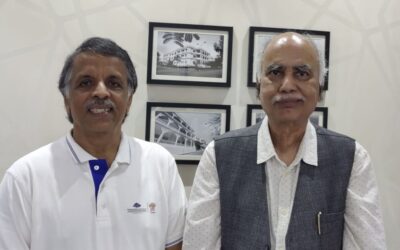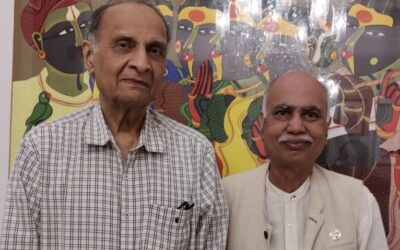Hyderabad was settled 500 years ago amid the vast expanse of stones and dust, a plateau beneath a hot sky. A part of it now bursts with high-rise glass towers, where the sun is mirrored when rising and setting. This new part is called Cyberabad, as though...

Spiritual Darning of Personality Holes
Spiritual Darning of Personality Holes
Darning, known as Rafookari in Hindi, is an umbrella term for a mending technique used to repair holes or worn areas in fabric or knitted materials by weaving a new piece of cloth or thread into the existing material. Often done by hand, this practice was prevalent in the past, and as a child, I recall seeing it used to extend the life of clothing and other items. In modern times, the need for it has reduced drastically. Clothes have become commodities, and the ‘use and throw’ trend is prevalent.
By spiritual darning, I mean addressing our personality defects through self-awareness. German-American psychiatrist Friedrich Salomon ‘Fritz’ Perls (1893-1970), the originator of Gestalt Therapy, and A. H. Almass (b. 1944), who promoted the Diamond Approach, discussed personality holes.
Personality is like clothing that we wear to function in society. Families, communities, professions and talents become part of our presentation and interactions. So, any hole in the personality reveals one’s nakedness—unless it is mended.
These ‘holes’ can manifest as unresolved conflicts, unmet needs, or incomplete development of certain aspects of the personality, leading to feelings of emptiness, dissatisfaction, or psychological distress. Some people are shy and unable to form connections. Some people hide their talents. Some avoid taking responsibility. Irritability, anxiety, lack of empathy, poor impulse control, low self-esteem, difficulty in decision-making, lack of resilience, procrastination, bad habits and addictions represent various holes of different sizes and shapes.
An unborn baby depends entirely on the mother for every aspect of its existence. A foetus gets all it needs—material for physical growth, oxygen, warmth, etc.—from the mother. After birth, the child must be able to breathe independently. The mother begins to wean the child after a few months, and as time passes, the child learns to crawl, walk, bite and chew, and becomes self-supportive, developing its own movements and awareness.
Next come choices. The child starts becoming demanding. Depending on what is available and what is not, and how its demands are met, each child develops their unique strategy and style to achieve their goals. It sorts out what works and writes a life script that guarantees its survival. The way we behave in later life is decided in our childhood.
But life is a two-way road. Demands are made upon the child, too: sit down, eat, speak, sleep, don’t cry, and so on. Some of these demands may be unreasonable, but the child must manage, nonetheless. Some of its potential is then alienated, repressed and projected in this process, manifesting as phoney behaviour—a fake smile, pretentious servitude, etc.—that can lead to cheating and deceit.
Ultimately, this divide between our biological and social existence results in ‘holes’—lacking the ‘eyes’ to see, a ‘heart’ to feel, a ‘spine’ to take a stand, and so on. Next comes compensation for what is lacking. If a person has a ‘hole’ for eyes, they project their gaze onto the environment and live in a state of self-consciousness, permanently haunted by the feeling that they are being watched, judged, or accused.
One can know a person by what is being exaggerated. If someone constantly brags about their wealth, cars, or luxury items, it suggests they may be of a low social status. Exaggerating accomplishments can be a way to cover up the fear of being overlooked. Embellishing personal stories may indicate a desire to appear more interesting or adventurous than one feels. Overstating difficulties could signal a need for empathy, attention, or be an excuse for not meeting expectations. Exaggerating one’s looks, strength, or fitness could indicate desperation to impress others.
The name ‘Diamond’, as used by A. H. Almass, symbolises clarity, purity and the eternal nature of the human soul—diamonds are forever. The soul expresses itself through love, compassion, goodwill, peace, strength, joy and clarity. Almaas views personality holes as leaks in one’s life-force, and his approach aims to help individuals become more self-aware.
The worst and most common hole is not having ‘ears’. Such individuals continue to speak and expect the world to listen to them. They close their ears to what others have to say and can only tell others what they need. Problems arise frequently when two such individuals are placed in a situation. Next is the hole of not seeing. Obvious facts are ignored by such people. They are bound to mess things up, and, naturally, they are rarely given bigger responsibilities and the rewards that come with them.
The human personality is like a dress covering the soul. A new dress will come only in the next life. Darning is inevitable, and you must do that yourself.
A third part of our lives is spent in sleep. Every night, everyone sleeps. Even those who work the night shift must sleep for a certain number of hours during the day. The purpose of sleep is twofold. One is physical rest and the other is mental housekeeping. Dreams are an integral part of the sleep cycle. Dreams reveal our holes—our blank spaces, areas of our life and aspects of our personality that we have disowned or avoided in waking life. All the elements of a dream are fragments of our personality—like chipped pieces from a broken artefact.
According to Almass’s method, acknowledging ignorance is the starting point of any inquiry. Inquiry can commence the moment you become aware of your lack of knowledge. Assuming you already know something makes any investigation impossible. Take nothing for granted and assume no facts. You are here in this world to know.
Our feelings of discomfort—aches, high blood pressure, non-cooperation by insulin in the blood, shortness of breath, bloated intestines, and so on—are all cries of ignorance. Feel these discomforts and address their root causes, rather than relying on pills and balms. We must also understand our emotions and behaviours—why am I angry, fearful, anxious, frustrated, elated, timid, or outspoken? We must explore this more thoroughly.
Your awareness is the price of direct knowledge. Like a burning flame, keep looking for answers to whatever is happening to you, and the path will appear before you, even if the future is unknown, like a deep and dark cave. The simple answer to the fundamental existential question of ‘Why am I here?’ is ‘I am here to know what I don’t know.’
So, whether by capturing through our dreams the emotions we avoid, or by understanding what lies beneath our emotions in our waking state, we must reclaim our awareness, which can serve as a means of healing and mending. Much like darning a piece of fabric to restore it, spiritual darning addresses wounds, gaps, or wear caused by life’s challenges, doubts, or disconnection from one’s inner self or higher purpose. A continuous process of repair and renewal allows us to live more consciously and move forward with greater clarity and resilience.
MORE FROM THE BLOG
On Meeting a Sage Among Machines
The Soul of Sustainable Chemistry
There are evenings when conversation lingers like the aftertaste of cardamom tea—subtle yet insistent. Last night was one of them. Eminent chemist and my long-standing friend, Dr. S. Chandrasekhar, hosted some of his dear scientist friends, and I had the honour of...
Green Leaders
I graduated in Mechanical Engineering from G.B. Pant University of Agriculture and Technology (GBPUAT) in the 1970s. I stayed there for ten years, earning a master’s degree and working as a teaching associate, before joining DRDO in 1982. During this period, I...








